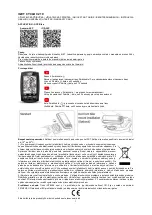
EN
9
5
Indicators
LED
ON / FLASHING
OFF
L1
(TX)
Mains power.
Non power or incorrect connection.
L2
(RX)
ON: better signal
In the first 20 minutes after giving power, the LED is
off in the absence of a received infrared signal.
After 20 minutes from power on, the LED remains off.
Flashing rapidly: strong signal.
In the first 20 minutes after switching on, the LED
flashes or is on steady if it receives an infrared signal.
Flashing slowly: weak signal.
L3
(RX)
Normally on. N.C. contact closed.
Obstacle detected. N.C. contact open.
6
Preliminary checks
• The mounting surfaces for the photocells must be clean, perfectly level and not subject to vibration.
• The maximum range is set in the factory to 15 m.
• For installations with a distance of less than 2.5 m between the transmitter
TX
and the receiver
RX
, remove
the lenses from the transmitter and receiver, taking care not to damage the photocell.
• The minimum permissible distance between transmitter and receiver is 80 cm.
7
Installation
1. Open the photocell units and remove the electronic circuit boards.
2. With the system disconnected from mains electricity, make the electrical connections as shown in fig. 3, 4 and 5.
Warning: with a 24V DC power supply, pay attention to the polarities. With a 24V AC power supply, connect
the negative pole (“-”) of the photocells to the common COM of the control unit.
3. Configure one pair of photocells as the MASTER pair (see fig.3) using the jumpers ID1 and ID2.
4. Configure, using the jumpers ID1 and ID2, any other pairs of photocells as SLAVE1, SLAVE2, SLAVE3, see fig. 4
and 5.
Warning: there cannot be SLAVE configurations equal to one another, and only one pair must be
configured as MASTER.
NOTE: Change the jumper position in absence of voltage.
5. Connect the photocells with the synchronisation wire (
SYNC
).
If the photocells are not connected, they
will NOT work.
6. Up to 4 pairs of synchronised photocells may be installed (1 3 SLAVEs).
7. Perform the alignment procedure before closing the photocells permanently, see chapter 8.
8
Alignment procedure
The alignment procedure must be performed on one pair of photocells at a time.
WARNING! The alignment of G90/F4ESI series photocells is limited by the existing wall layouts.
1. Turn on the power supply.
2. Position the
RX
receiver and the
TX
transmitter by aligning the two devices optically.
3. For the first 20 minutes after switching on, the LED
L2
flashes faster the more signals are received, until it
remains on steady with a maximum signal. LED
L2
switches off after 20 minutes. To check the alignment
again, turn the power off and on again.”
4.
LED
L3
must remain on to indicate that the N.C. contact is closed. If it is off, it means that the contact is open
and that the photocell detects an obstacle.
5. Fix the photocell permanently.
6. Position the O-ring (detail
B
fig.2) in its housing in the upper casing.
7. Position the gasket (detail
C
fig.2) on the upper casing. Fix it with the screws supplied.
8. Carefully press on the escutcheon plate (detail
D
fig.2) to attach it to the casing.
Summary of Contents for G90/F4ESI
Page 23: ...23 ...










































